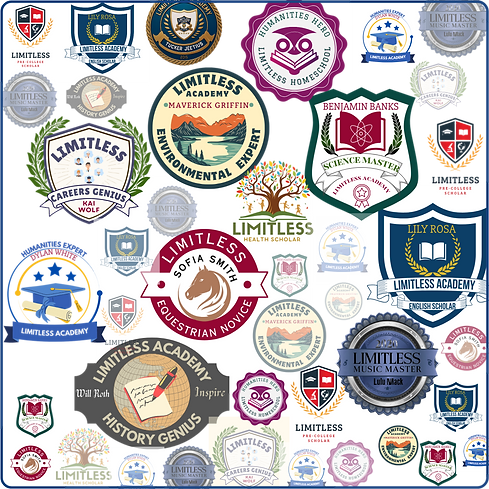Family Access to 1400+ Self Educating MicroCourses That Matter
TURNING POINT ACADEMY

Because We Are All Charlie Kirk Now TM
Schools do not educate anymore.
Schools ruins the ability to think and reason.
School indoctrinates students and represses speech
Schools and universities breed violence and hate. Charlie Kirk

What Are Digital Badges?
Digital badges are electronic credentials awarded to students for accomplishing specific tasks, mastering skills, or demonstrating key competencies. Unlike traditional grades, digital badges are highly customizable and can represent academic, extracurricular, or even social-emotional milestones. Each badge is embedded with metadata, providing evidence of what the student achieved, when, and how.
Digital Badges
Unleashing Student Potential: How Digital Badges Improve Learning Outcomes in K-12 Schools
As education evolves to meet the needs of 21st-century learners, K-12 schools are increasingly seeking innovative ways to motivate students and foster deeper engagement. Among the most promising tools in this landscape are digital badges—dynamic, visual representations of skills, achievements, and mastery that students can earn throughout their educational journey. Digital badges have the power to revolutionize learning outcomes by incentivizing students, encouraging exploration, and driving achievement to new heights.
The Motivational Power of Badges
Research consistently demonstrates that recognition and feedback are critical motivators** in learning. Digital badges leverage both:
Immediate Recognition: Students receive badges as soon as they meet a goal, providing instant acknowledgment of their efforts.
Tangible Progress: Seeing a collection of badges grow gives students a clear visual representation of their achievements, building self-esteem and persistence.
A 2018 study published in the Journal of Educational Technology & Society found that students who could earn badges for meeting specific milestones were "more engaged and proactive in their studies" than those who only received traditional grades. Badging systems tap into students' intrinsic and extrinsic motivation, encouraging them to take ownership of their learning.
Inspiring Exploration and Lifelong Learning
One of the most compelling aspects of digital badges is their ability to encourage exploration. Because badges can be awarded for a variety of accomplishments—ranging from mastering a challenging math concept, coding a new program, participating in an art competition, or demonstrating leadership—students are incentivized to venture beyond the core curriculum and try new activities.
Badges also support personalized learning pathways, allowing students to pursue areas of interest at their own pace. This flexibility encourages students to take risks, explore unfamiliar subjects, and develop diverse skills—all essential for success in an ever-changing world.
Real-World Success Stories
Schools across the globe are already witnessing the transformative impact of digital badge programs:
Summit Public Schools in California implemented a badging system to recognize a wide range of student achievements—including collaboration, perseverance, and subject mastery. As a result, students reported feeling more motivated, with an increased willingness to tackle difficult assignments.
Chicago Public Schools introduced digital badges to encourage STEM exploration. Teachers noted a marked uptick in participation in after-school science and robotics clubs, as students were eager to collect and share their digital accomplishments.
Boosting Achievement and College Readiness
Badges don’t just motivate—they improve learning outcomes. When students can see clear, achievable goals represented by badges, they are more likely to stick with challenging tasks, leading to higher mastery rates.
Additionally, digital badges can:
Demonstrate skill mastery: Badges provide clear evidence of learning, helping teachers and parents track student growth over time.
Support college and career readiness: Students can showcase their badges in digital portfolios or applications, demonstrating a range of skills often missing from report cards.
Build a growth mindset: Badges reinforce that learning is a continuous journey, celebrating every step of progress.
Integrating Digital Badges Into K-12 Curricula
For badges to be truly effective, schools should align them with meaningful learning objectives and ensure transparency about what each badge represents. Strategies for successful integration include:
Collaborate with teachers: Develop badge criteria together so they reflect important skills and standards.
Leverage existing technology: Use learning management systems that support badging, making distribution and tracking seamless.
Engage students in design: Let students help create badge themes or challenges, increasing buy-in and relevance.
Conclusion: Reaching Higher, Together
As K-12 education continues to evolve, digital badges offer a powerful, flexible tool for incentivizing student growth, encouraging exploration, and driving higher achievement**. By recognizing a wide range of accomplishments, digital badges not only celebrate what students already know but inspire them to reach for more—unlocking potential and preparing them for success in school and beyond.
 |  |  |  |
|---|---|---|---|
 |  |  |  |





